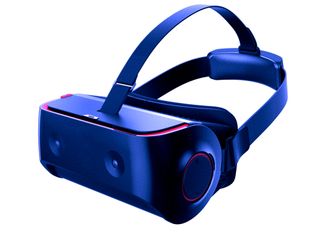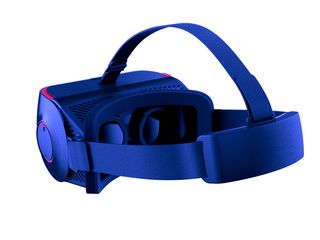Qualcomm Launches VR HMD Accelerator Program, Offers Dev Kits

Qualcomm continues its push into the VR market with the announcement of its new Qualcomm HMD Accelerator Program and a new VR dev kit. The former’s aim is to give manufacturers an easier time developing new hardware at lower costs with ostensibly high quality, and the latter is meant to give content creators a solid base upon which to build. Thus, Qualcomm is engaging with VR on two fronts at the same time, in a way.
This is complementary to its efforts with the Snapdragon 835 SoC, a chip built for “immersive experiences” that launched along with Osterhout Design Group’s R8 and R9 AR glasses.
Pillars And Such
Qualcomm said there are five “pillars” to the program:
1. A Qualcomm reference design: Snapdragon 835 VR headset, including schematics and other design files. 2. Validated ODMs: The first two enabled ODMs in the program are Thundercomm and GoerTek. 3. Validated component and technology suppliers include Leap Motion and SMI, among others. 4. Hardware quality metrics and validation methodologies. 5. Qualcomm marketing support and endorsements.
In addition to access to the reference design and “pre-qualified” components, program participants will be able to collaborate with other tech companies to get their hands on validated software that already supports the components in question, quality metrics, testing methods, accessories, “and more.”
The HMD Accelerator Program launches today.

Also, A Dev Kit
Stay on the Cutting Edge
Join the experts who read Tom's Hardware for the inside track on enthusiast PC tech news — and have for over 25 years. We'll send breaking news and in-depth reviews of CPUs, GPUs, AI, maker hardware and more straight to your inbox.
Whereas the HMD Accelerator Program is designed to help manufacturers build better VR hardware, the Qualcomm Snapdragon 835 Virtual Reality Development Kit (Snapdragon VRDK) is there to help content creators develop new VR experiences.
The Snapdragon VRDK includes a VR HMD built on the Snapdragon 835 and the Snapdragon VR SDK. Features of the VRDK include:
1. DSP sensor fusion: The new SDK enables developers to create more responsive and immersive experiences with six degrees of freedom (6 DOF). This is easily done by accessing the right combination of camera positional data, high frequency inertial data from gyroscopes and accelerometers via the Snapdragon Sensor Core, and predictive head position processing with the Qualcomm Hexagon DSP. 2. Foveated rendering: New Snapdragon plugin support for the latest Unity 3D and Unreal Engine 4 enables a rendering technique useful for VR. It senses the user’s gaze direction and focuses on processing the maximum visual detail only in the region of interest. 3. Fast motion to photon: Supports improved asynchronous time warp with single buffer rendering and other techniques for fast transformation of rendered images in 3D space, helping to reduce latency by approximately 20% when compared to previous Snapdragon products. 4. Stereoscopic rendering with lens correction: Supports 3D binocular vision with color correction and barrel distortion for improved visual quality of graphics and video, enhancing the overall VR experience. 5. VR layering: Generates menus, text, and other overlays so that they render correctly in a virtual world, reducing distortions that would otherwise make them difficult to read. 6. Advanced Application Profiling and Power management: Integration with Snapdragon Profiler and the Qualcomm Symphony System Manager SDK provides application developers with greater visibility into the VR processing pipeline. It also offers cohesive CPU, GPU, and DSP power and performance management to help achieve stable frame rates for VR applications running in low-power, thermally constrained devices.
Alert readers will note that Qualcomm already has a VR dev kit out there, the VR820. Therefore, the release of the VR835 seems a mite curious. What gives? Jim Merrick, Qualcomm’s IoT Marketing Director, explained to Tom’s Hardware:
We already had visual inertial odometry (VIO) based 6DoF (six degrees of freedom) on VR820. And Snapdragon 835 comes with further improved performance of 6DoF and lower power consumption. VR835 will build on that momentum for 2H17 launches. More importantly with the Adreno 540, we’ve been able to decrease the motion to photon latency from about 18 milliseconds on the Snapdragon 820 to 14.5 milliseconds on the Snapdragon 835, an improvement of about 20%.
He further noted that with the VR820, Qualcomm really just wanted to create a first reference platform for standalone HMDs--which it accomplished, he said. The VR835, then, could be seen as a second-gen effort of sorts.
| Header Cell - Column 0 | Snapdragon 835 HMD |
|---|---|
| Display | 4MP (2560x1440) WQHD AMOLED display (2MP per eye) |
| 6DoF Motion Tracking | -Two monochromatic, stereo 1MP (1280x800) cameras with fish-eye lenses -Integrated sensor IMU (gyroscope, accelerometer, magnetic compass), with fast interface to the Snapdragon 835 mobile platform sensor core |
| Eye Tracking | -Two monochromatic VGA global shutter cameras with active depth sensing |
| Memory | 4GB LPDDR4 RAM |
| Storage | 64GB flash UFS |
| Connectivity | Wi-Fi, Bluetooth, USB 3.1 Type-C with Power Delivery |
| Audio | Integrated Qualcomm Aqstic audio codec (WCD9335) |
| I/O | Trackpad on right side of HMD |
| Availability | 2H17 |
What To Expect
The company’s ability to offer foveated rendering means that SMI’s eye tracking is of central importance. Qualcomm has not said whether it’s working with other eye-tracking companies, but a representative told us earlier that Qualcomm considers SMI “the leaders in the space,” so at the very least, SMI is the favorite child at this point.
With the presence of Leap Motion in the HMD Accelerator Program, that means Qualcomm is giving manufacturers the ability to offer both eye- and hand-tracking in their headset.
To be clear, though, what’s most important about all of the above is that Qualcomm is offering all-in-one headset designs that do not need a smartphone or a PC, with 6DoF tracking. This is (part of) the consumer-level XR panacea; all it’s missing is some manner of passthrough to create mixed reality HMDs, too.
We’ve seen this accomplished in one of two ways: Either you can build an HMD with transparent lenses, like HoloLens, or you can add a camera passthrough, which Intel and Vrvana have employed, albeit in slightly different ways. Qualcomm was probably purposely vague about some of the details of the HMD Accelerator Program to allow for the possibility of either, and if we had to guess, we’d say that we could see both.
At the tail end of the HMD Accelerator Program announcement, Qualcomm stated: “In addition, next generation chipsets will follow the program and our goal is to have Augmented Reality integrated as part of the program in the coming months.“ We’re purely speculating here, but we read that to say that AR is coming, but probably not until there’s a new chip. However, it leaves open the possibility that a component-making participant in the program could bring a passthrough camera to the platform. Besides, Qualcomm noted that “Over the coming months, we expect the list of partners to grow.”
Even without a passthrough, building all-in-one VR HMDs is of utmost importance for mainstream VR adoption. This also signals the launch of a bona fide platform war between Intel and Qualcomm for the all-in-one HMD market, and Qualcomm is waging it on multiple fronts.
Update, 2/23/17, 5:21am PT: Added HMD specifications.
-
bit_user The 835's 60 fps limit is gonna be an issue. I still can't believe that.Reply
However, the display of 2560x1440 was a bold move.
We’re purely speculating here, but we read that to say that AR is coming, but probably not until there’s a new chip.
Actually, I think you're underestimating the complexity of AR. As you noted, it involves more components. Also, the software is also more complex. So, starting with a VR design is a good stepping stone.
Most Popular






